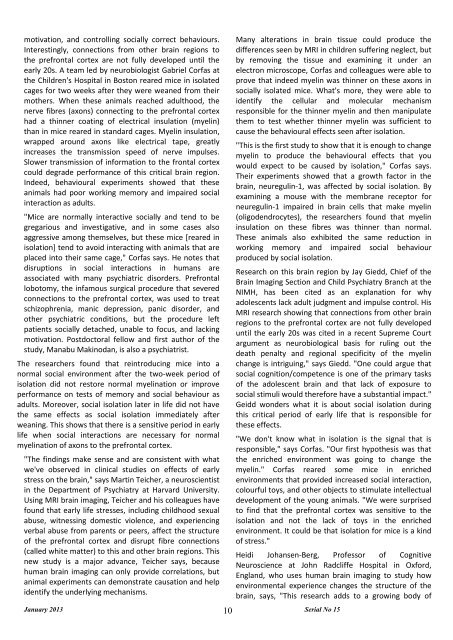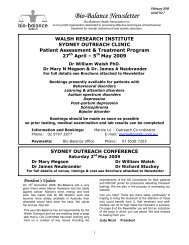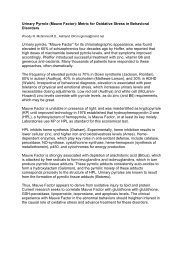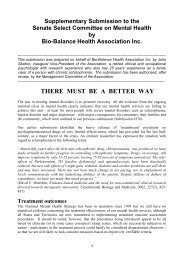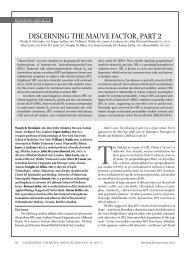Download PDF - Bio-Balance Health
Download PDF - Bio-Balance Health
Download PDF - Bio-Balance Health
- No tags were found...
You also want an ePaper? Increase the reach of your titles
YUMPU automatically turns print PDFs into web optimized ePapers that Google loves.
motivation, and controlling socially correct behaviours.Interestingly, connections from other brain regions tothe prefrontal cortex are not fully developed until theearly 20s. A team led by neurobiologist Gabriel Corfas atthe Children's Hospital in Boston reared mice in isolatedcages for two weeks after they were weaned from theirmothers. When these animals reached adulthood, thenerve fibres (axons) connecting to the prefrontal cortexhad a thinner coating of electrical insulation (myelin)than in mice reared in standard cages. Myelin insulation,wrapped around axons like electrical tape, greatlyincreases the transmission speed of nerve impulses.Slower transmission of information to the frontal cortexcould degrade performance of this critical brain region.Indeed, behavioural experiments showed that theseanimals had poor working memory and impaired socialinteraction as adults."Mice are normally interactive socially and tend to begregarious and investigative, and in some cases alsoaggressive among themselves, but these mice [reared inisolation] tend to avoid interacting with animals that areplaced into their same cage," Corfas says. He notes thatdisruptions in social interactions in humans areassociated with many psychiatric disorders. Prefrontallobotomy, the infamous surgical procedure that severedconnections to the prefrontal cortex, was used to treatschizophrenia, manic depression, panic disorder, andother psychiatric conditions, but the procedure leftpatients socially detached, unable to focus, and lackingmotivation. Postdoctoral fellow and first author of thestudy, Manabu Makinodan, is also a psychiatrist.The researchers found that reintroducing mice into anormal social environment after the two-week period ofisolation did not restore normal myelination or improveperformance on tests of memory and social behaviour asadults. Moreover, social isolation later in life did not havethe same effects as social isolation immediately afterweaning. This shows that there is a sensitive period in earlylife when social interactions are necessary for normalmyelination of axons to the prefrontal cortex."The findings make sense and are consistent with whatwe've observed in clinical studies on effects of earlystress on the brain," says Martin Teicher, a neuroscientistin the Department of Psychiatry at Harvard University.Using MRI brain imaging, Teicher and his colleagues havefound that early life stresses, including childhood sexualabuse, witnessing domestic violence, and experiencingverbal abuse from parents or peers, affect the structureof the prefrontal cortex and disrupt fibre connections(called white matter) to this and other brain regions. Thisnew study is a major advance, Teicher says, becausehuman brain imaging can only provide correlations, butanimal experiments can demonstrate causation and helpidentify the underlying mechanisms.Many alterations in brain tissue could produce thedifferences seen by MRI in children suffering neglect, butby removing the tissue and examining it under anelectron microscope, Corfas and colleagues were able toprove that indeed myelin was thinner on these axons insocially isolated mice. What's more, they were able toidentify the cellular and molecular mechanismresponsible for the thinner myelin and then manipulatethem to test whether thinner myelin was sufficient tocause the behavioural effects seen after isolation."This is the first study to show that it is enough to changemyelin to produce the behavioural effects that youwould expect to be caused by isolation," Corfas says.Their experiments showed that a growth factor in thebrain, neuregulin-1, was affected by social isolation. Byexamining a mouse with the membrane receptor forneuregulin-1 impaired in brain cells that make myelin(oligodendrocytes), the researchers found that myelininsulation on these fibres was thinner than normal.These animals also exhibited the same reduction inworking memory and impaired social behaviourproduced by social isolation.Research on this brain region by Jay Giedd, Chief of theBrain Imaging Section and Child Psychiatry Branch at theNIMH, has been cited as an explanation for whyadolescents lack adult judgment and impulse control. HisMRI research showing that connections from other brainregions to the prefrontal cortex are not fully developeduntil the early 20s was cited in a recent Supreme Courtargument as neurobiological basis for ruling out thedeath penalty and regional specificity of the myelinchange is intriguing," says Giedd. "One could argue thatsocial cognition/competence is one of the primary tasksof the adolescent brain and that lack of exposure tosocial stimuli would therefore have a substantial impact."Geidd wonders what it is about social isolation duringthis critical period of early life that is responsible forthese effects."We don't know what in isolation is the signal that isresponsible," says Corfas. "Our first hypothesis was thatthe enriched environment was going to change themyelin." Corfas reared some mice in enrichedenvironments that provided increased social interaction,colourful toys, and other objects to stimulate intellectualdevelopment of the young animals. "We were surprisedto find that the prefrontal cortex was sensitive to theisolation and not the lack of toys in the enrichedenvironment. It could be that isolation for mice is a kindof stress."Heidi Johansen-Berg, Professor of CognitiveNeuroscience at John Radcliffe Hospital in Oxford,England, who uses human brain imaging to study howenvironmental experience changes the structure of thebrain, says, "This research adds to a growing body ofJanuary 2013 10Serial No 15


